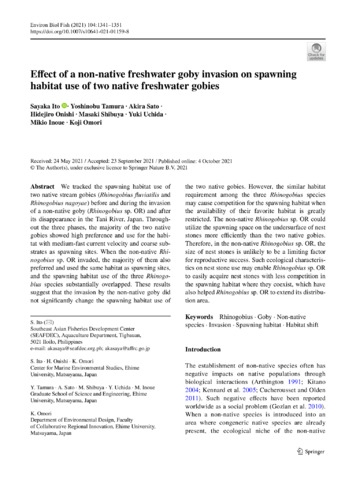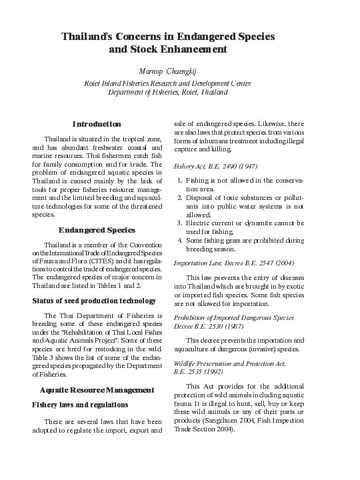Effect of a non-native freshwater goby invasion on spawning habitat use of two native freshwater gobies
- Global styles
- MLA
- Vancouver
- Elsevier - Harvard
- APA
- Help
Share
Abstract
We tracked the spawning habitat use of two native stream gobies (Rhinogobius fluviatilis and Rhinogobius nagoyae) before and during the invasion of a non-native goby (Rhinogobius sp. OR) and after its disappearance in the Tani River, Japan. Throughout the three phases, the majority of the two native gobies showed high preference and use for the habitat with medium-fast current velocity and coarse substrates as spawning sites. When the non-native Rhinogobius sp. OR invaded, the majority of them also preferred and used the same habitat as spawning sites, and the spawning habitat use of the three Rhinogobius species substantially overlapped. These results suggest that the invasion by the non-native goby did not significantly change the spawning habitat use of the two native gobies. However, the similar habitat requirement among the three Rhinogobius species may cause competition for the spawning habitat when the availability of their favorite habitat is greatly restricted. The non-native Rhinogobius sp. OR could utilize the spawning space on the undersurface of nest stones more efficiently than the two native gobies. Therefore, in the non-native Rhinogobius sp. OR, the size of nest stones is unlikely to be a limiting factor for reproductive success. Such ecological characteristics on nest stone use may enable Rhinogobius sp. OR to easily acquire nest stones with less competition in the spawning habitat where they coexist, which have also helped Rhinogobius sp. OR to extend its distribution area.
Keywords
Goby Invasion Spawning habitat Habitat shiftSuggested Citation
Ito, S., Tamura, Y., Sato, A., Onishi, H., Shibuya, M., Uchida, Y., Inoue, M., & Omori, K. (2021). Effect of a non-native freshwater goby invasion on spawning habitat use of two native freshwater gobies. Environmental Biology of Fishes , 104(10), 1341-1351. https://doi.org/10.1007/s10641-021-01159-8
Type
ArticleISSN
0378-1909; 1573-5133Collections
- Journal Articles [1258]
Related items
Showing items related by title, author, creator and subject.
-
Occurrence and disappearance of a non-native goby Rhinogobius sp. OR in relation to hydrological conditions in the Kamo River, southwestern Japan
Ito, Sayaka ; Tamura, Yoshinobu; Sato, Akira; Onishi, Hidejiro; Shibuya, Masaki; Uchida, Yuki; Inoue, Mikio; Omori, Koji (Springer, 2022-01)
We monitored the abundance of a non-native (Rhinogobius sp. OR) and two native stream gobies (R. fluviatilis and R. nagoyae) over a decade, from 1995 to 2004, in a fixed reach of a tributary of the Kamo River, southwestern ...
; Tamura, Yoshinobu; Sato, Akira; Onishi, Hidejiro; Shibuya, Masaki; Uchida, Yuki; Inoue, Mikio; Omori, Koji (Springer, 2022-01)
We monitored the abundance of a non-native (Rhinogobius sp. OR) and two native stream gobies (R. fluviatilis and R. nagoyae) over a decade, from 1995 to 2004, in a fixed reach of a tributary of the Kamo River, southwestern ... -
Thailand's concerns in endangered species and stock enhancement
Chaengkij, Marnop (Aquaculture Department, Southeast Asian Fisheries Development Center, 2006)The paper provides a comprehensive list of endangered freshwater, brackishwater, and marine aquatic species in Thailand. The Thai Department of Fisheries is breeding some of the endangered species under the “Rehabilitation ... -
Low isozyme variation in native and transplanted populations of the endemic Philippine silver perch, Leiopotherapon plumbeus (Kner, 1864) from three lakes in the Philippines
Quilang, Jonas P.; Basiao, Zubaida U.; Pagulayan, Roberto C.; Roderos, Remedios R.; Cao, Ernelea P. (College of Agriculture, University of the Philippines Los Baños, 2008)The silver perch, Leiopotherapon plumbeus (Kner, 1864), is an endemic and economically important fish in the Philippines. A native species of Laguna de Bay, the silver perch was transplanted from this lake to Sampaloc Lake ...






